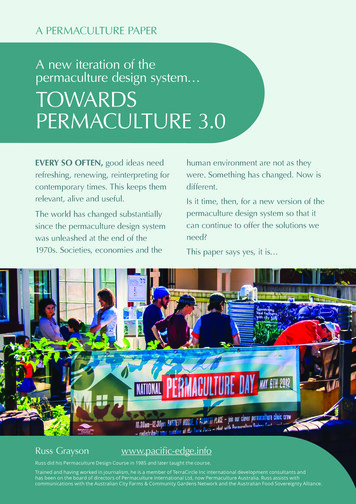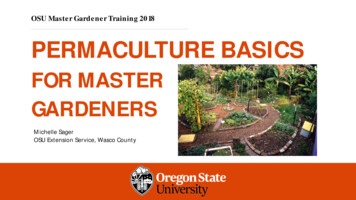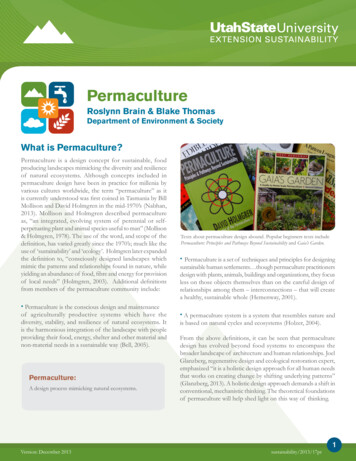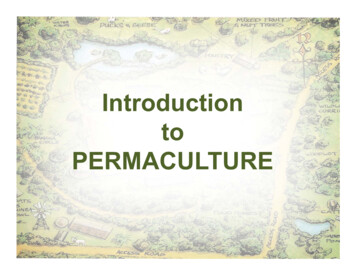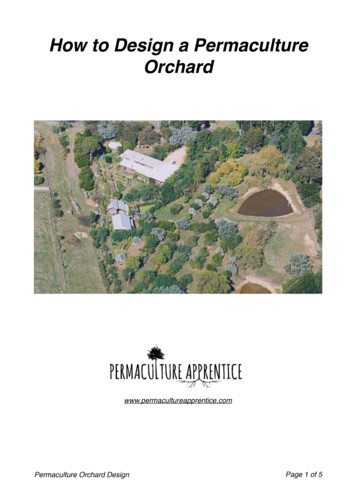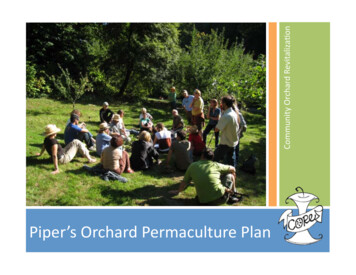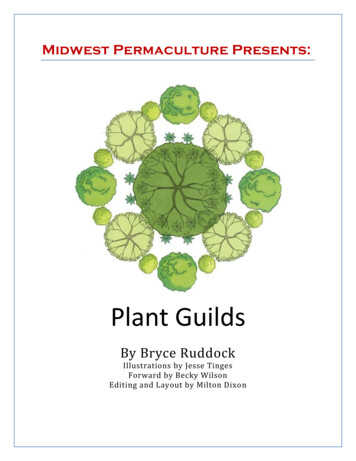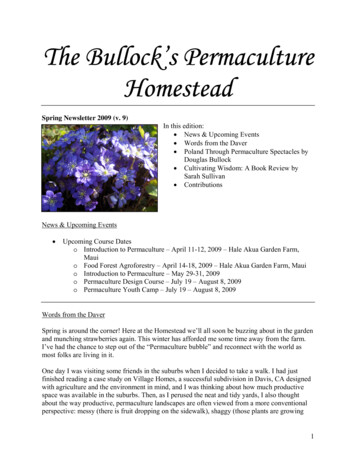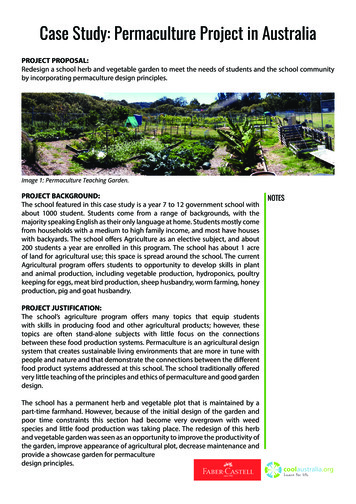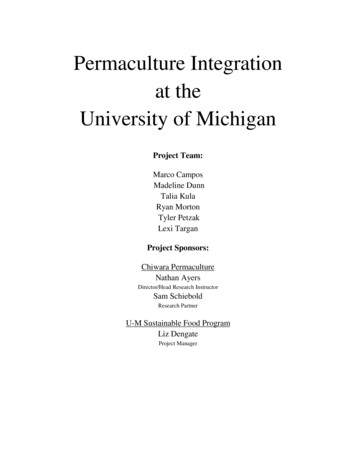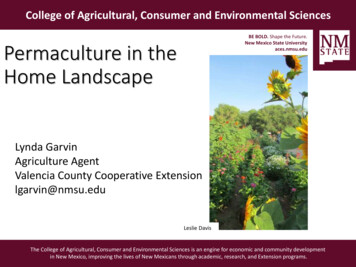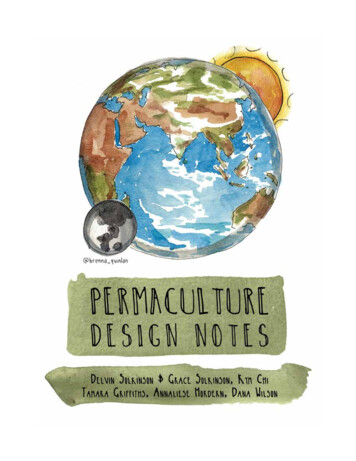
Transcription
Permaculture Design Maestra November 21.indd 12020-11-24 10:59 PM
Offered free download for the world redesignnotesThis is a work in progress, integrating feedback and new learnings.Make sure you have the newest, most updated edition.May 2021 rmaculture.comwww.permaculturedesign.ca
“Let’s embrace sustainability not because we fear the future.Let’s embrace sustainability because we love the things we love about right now”- Larry SantoyoThis book is dedicated to the beloved World Community.
We acknowledge the information in this text, passed down from pioneers ofPermaculture, has deepest roots in the traditional cultures of the world. Werecognize and give gratitude to all of the traditional cultures and their peopleas the source of permaculture and ecological knowledge. The permaculturemovement is the modern expression of a lineage of earth centeredunderstandings that is inherited from all who have come before us.We hold the deepest appreciation and thanks for all the Traditional People whohave shared their wisdom and learnings from the natural world so that we can inturn reconnect and heal our relationships with ourselves, each other and the land.As settlers to the traditional territories where we reside, we are all grateful tolive, work, play and help steward the land. We acknowledge that it would notbe possible to be where we are without the ancestors of the land, their manycontributions and sacrifices. We honour all of the living Indigenous Peoples whocontinue to steward the lands and carry the torch of their ancestral knowledge.If you too are a settler to the land where you live, we encourage you to familiarizeyourself with the land, learn about the Traditional Peoples, their culturalpractices, plants with a history of use, traditional foods and seek ways to supporttheir culture to thrive. As a path towards reconciliation, seek ways to decolonizeyourself and reconnect with your ancestral roots.How can you become more naturalized to the area where you live, acting as afriend and ally to the land and to the traditional peoples of the land?“Being naturalized to place means to live as if this is the land that feeds you,as if these are the streams from which you drink, that build your body and fillyour spirit. To become naturalized is to know that your ancestors lie in thisground. Here you will give your gifts and meet your responsibilities. To becomenaturalized is to live as if your children’s future matters, to take care of the land asif our lives and the lives of all our relatives depend on it. Because they do.”- Robin Wall Kimmerer
“Between every two pines is a doorway to a new world.”- John MuirOffered freely to the world community as a download, this book sharespermaculture design to bring benefit to our collective present and future.Delvin Solkinson entirely volunteers to create and distribute this work.Gratitude to the generosity of many teachers, mentors, students, peers and friendsfor collaborating on this group project.Deepest of thanks to all the Permaculture Pioneers who contributed, directly orindirectly, to this work.
Copyright 2021 by Permaculture Design.We welcome you to copy, distribute, display and share this work as long asclear attribution is given and it’s not being resold commerciallyOpen Source Permaculture : As Earth Beings this information is your birthright!Download the file freely and ignnotesContact delvin@cosm.orgFirst Printing : 2021978-1-954146-00-6Visionary Permaculture Permaculture Design46 Deer Hill Road, Wappingers Falls, NY, 12590, sign.earthPermaculture Design1427 B Bonniebrook Heights Road,Gibsons, BC, V0N 1V5, Canadawww.permaculturedesign.caHard Copies are available for purchaseWholesale discounts are offeredEmail delvin@cosm.org for more infoPermaculture Design is an evolving field. If you see any content that newmainstream science has proven otherwise through experimentation and testing,please let us know and we will do our own research to see if this could bechanged in the next edition.Our highest dream is to have this book published by a publisher with globaldistribution. We also envision different language editions.Every effort has been made to provide accurate information. We apologize forany mistakes and will resolve inaccurate or missing information in subsequentreprintings of this book.
‘Time Scout’ Portrait of Bill Mollison by Martin Bridge
“As we read this, we stand in the plane of the present; we are the sum of all ourancestors, and the origin of all our descendants. In terms of our model, we areat an ever-changing origin, located on the boundary of past and future. As well,we are spinning with the earth, spiralling with the galaxy, and expanding orcontracting with the universe. We are on the move in time and space.The global village community. is the most remarkable revolution in thought,values, and technology that has yet evolved. the philosophy of a new anddiverse approach to land and livingWe permaculture teachers seek to empower any person by practical modelmaking and applied work, or data based on verifiable investigations.Permaculture is information and imagination intensive if we take the timeto read, observe, discuss, and contemplate, we begin to think in terms ofmultidisciplines, and to design systems which save energy and give us yields.I believe the key word here is commitment. Self-government is the first thing eachindividual has got to learn. Each person must make up his or her own mind andmake a commitment. only then is he or she ready to go out and convince others.We all have to start within ourselves and get our own houses in order. and thenwe’ll be ready to become missionaries for order.It’s a revolution. But it’s the sort of revolution that no one will notice. It might geta little shadier. Buildings might function better. You might have less money toearn because your food is all around you and you don’t have any energy costs.Giant amounts of money might be freed up in society so that we can provide forourselves better. So it’s a revolution. But permaculture is anti-political. There isno room for politicians or administrators or priests. And there are no laws either.The only ethics we obey are : care of the earth, care of people, and reinvestmentin those ends.There is no other path for us than that of cooperative productivity and communityresponsibility. Take that path, and it will change your life in ways you cannot yetimagine.If you want to change the world, start at your back doorstep.”- Bill Mollison, co-founder of Permaculture
This work was created with the support of the Permaculture Institutewww.permaculture.orgDelvin Solkinson is the Diploma Program Co-ordinator.The Peoples Diploma is a form of continuing education after the PermacultureDesign Course (PDC). The PDC can be truly life changing, the Diploma helpsstudents activate themselves post-PDC while providing a structure to support theirwork. This participant-driven program is designed for self-motivated learners whowant to choose their own texts, site visits, design projects, and teachers to learnwith, while being guided by a structure to complete their work. Participants createtheir own learning design in consultation with our staff, allowing them to applypermaculture to their own passions. Check-ins with our staff provide resourcesand direction for helping participants stay on course. The Peoples Diplomaemphasizes contribution to the human and ecological community and is open tothose working to create change after completing their PDC.www.permaculture.org/diploma“Permaculture comes out of a storytelling tradition. Bill Mollison was the ultimatestoryteller. He told stories that were just unbelievable! As I travel and spendtime in other cultures, I see that is part of how people communicate truth isthrough stories. Taking the permaculture design course is the new beginning ofcreating your own stories, of understanding that your story has value. It’s worthremembering those stories and remembering your grandfather’s stories, it’s away to communicate your humanity. These courses are what hold the light.”- Scott Pittman
This book was created with the support of the Permaculture Associationwww.permaculture.org.ukDelvin Solkinson is engaged in ongoing training as a Diploma Tutor and part ofa vibrant network that helps people put permaculture theory into practice anddevelop a range of new skills.The Diploma in Applied Permaculture Design is one of many ways to learn aboutpermaculture and improve skills as a designer.The Diploma is a distance learning course by the Permaculture Association.As an apprentice participants will produce a portfolio of ten designs that willdemonstrate how they develop into a proficient permaculture designer. It isup to each participant which areas of their life and work the designs cover. It isexpected that some of them will be land based and some of them cover non-landbased subjects, such as education, community development, self care or �Pro-active creative education is an exciting, challenging and effective pathtoward a truly sustainable society, or should I say Perma(nent)Culture.In looking back we realize that what we have been doing is applying theprinciples of Permaculture to a landscape called the ‘classroom’we have permacultured education.”- Andy Goldring
This new edition of Permaculture Design Notes was done as part of a pilot projectDoctorate and Post-Doc in Permaculture Education thanks to the extraordinarymentorship of Larry Santoyo and the Permaculture Academy. Without theirsupport this book would not have happened. This educational program isongoing and will result in the creation of future editions of this book.Permaculture Academy trains the next generation of thought leaders that willsteward systems that are regenerative and environmentally, socially, and economysustainable.As an internationally recognized school of Permaculture Design, the PermacultureAcademy focuses on practical, tangible, and actionable principles and tools thathonor permaculture’s pioneering history while also maintaining a clear focus onthe future.www.permacultureacademy.com“True riches are having something to contribute, having the time to be creativeand being in love with everything again”- Larry Santoyo
EDUCATIONAL PATHWAYSDelvin Solkinson created this book as an ongoing projectalong a number learning journeys taking classes, courses,permaculture design certificate courses andteacher trainings between 2003-2020 including :PDC, Diploma and Masters Degree with Bill MollisonPermaculture Institute www.tagari.comDiploma with Larry Santoyo & Scott PittmanPermaculture Institutewww.permaculture.orgDiploma with Looby MacnamaraPermaculture Associationwww.permaculture.org.ukPDC and Teacher Training with Geoff LawtonPermaculture Research Institutewww.permaculturenews.orgExperimental, non-accredited Doctoral Degreewith Larry Santoyo & Permaculture Academywww.permacultureacademy.com
SUPPORT“This carefully curated collection from Delvin Solkinson’s 18 year journey is awonderful reference that will prove to be the perennial words of positive workseverywhere.”- Larry Santoyo, Permaculture Academy www.permacultureacademy.com“This is a foundational work that will inform and guide many into the future. Iam deeply inspired and grateful for the immensely valuable contribution of thePermaculture Design Core Curriculum Notes. Everyone interested in learning,teaching and facilitating permaculture will benefit from this very practical andbeautifully crafted text. It skillfully weaves together essence, depth of contentand the ‘Fair Share’ ethic. It researches and brings forward wisdom and teachingsfrom the past, flavours it with present brilliance and developments and offers afoundation for the next evolution of Permaculture.”- Robin Clayfield www.dynamicgroups.com.au“This is a dense but well formatted book offering many strategies andtechniques to teachers, designers and practitioners. Delvin and the team havesummarized most of the knowledge we hold in permaculture. The summariescollate all material and information used by most teachers. I could see Delvin’sencyclopaedic mind through it all. The team deserves a huge “thank you” forpulling all this together. It works best through its checklists and summaries. Thisbook gives abundantly and freely to all people - permaculturists or not.”- Rosemary Morrow rmaculture offers a set of tools to design sustainable lifestyles. PermacultureDesign Notes brings together the many elements that creates this integral wholesystem. The Foundational Concepts offer the reader a window into buildingblocks of Permaculture. As the book evolves, a Permaculture curriculum unfoldsoffering a guide to anyone who wants to practice and/or share the knowledgeof this effective system in any environment- from teaching children to adults todirect application on the land and in community. This is a book of succinct andcontemplative lists and critical thinking questions providing ideas to springboardthe reader to further research and application.”- Jude Hobbs Cascadia Permaculture www.cascadiapermaculture.com
“Amazing energy and input. This is a gift to Permaculture.”- Looby Macnamara www.loobymacnamara.com“A wonderful effort and full of great information.”- Max Lindegger www.ecologicalsolutions.com.au“The book provides a useful summary for teachers and students of permaculturealike. It is well designed, thought provoking, and clear. I am going to be leafingthrough this potent, comprehensive collection for some time.”- Maddy Harland, Editor & Co-Founder of Permaculture Magazinewww.permaculturemag.org“Scope and Depth. All projects, be they land or life require both to be successful.In an international pilgrimage to permaculture pioneers, practitioners and projectsDelvin Solkinson has deftly crafted this tome sourcing from over two dozen livingpillars of wisdom. For craftspeople, seeking high grade tools to progress theirwork in regenerative living, I recommend this book. My sincere gratitude for this work.”- Javan K. Bernakevitch www.allpointsdesign.ca“Permaculture Design Notes provides permaculture teachers, students, andpractitioners with a holistic outline for permaculture literacy. This book deserves aplace on your bookshelf next to Bill Mollison’s Permaculture: A Designers’ Manual.”- Scott Mann www.thepermaculturepodcast.com“The Design Notes are way more than just an outline of the Permaculture DesignCourse curriculum. They are an index to a whole process, from the culture ofa class and presence of an instructor, to a road map of where students can gobeyond the PDC. It’s always fascinating to see how someone as deeply studiedas Delvin arranges and sequences the curriculum, borne of his own trial anderror and the trials and errors of his mentors and teachers. I will definitely bereferencing this text as I do my own work, and am very appreciative that this is puttogether as an open source document to lift up all teachers in the Permaculture field.”- Andrew Millison www.permaculturerising.com
PERMACULTURE DESIGN NOTESManaging Editor : Delvin SolkinsonContributing Editors : Delvin Solkinson & Grace Solkinson, Kym Chi,Tamara Griffiths, Annaliese Hordern, Dana WilsonProof Readers and Copy Editors : Niki Hammond, Tes TeslaProof Readers : Stephanie Johnson, Kate HouleArt & Illustration : Brenna QuinlanDesign : Alexa SpaddyText Design & Typesetting : Sijay JamesPen & Ink Art Portraits : Ben TourVisionary Art Portrait of Bill Mollison : Martin BridgeSource Curriculum : Bill Mollison, David Holmgren, Rosemary Morrow,Toby Hemenway, Robin Clayfield, Larry Santoyo, Michael Becker,Looby Macnamara, Scott Pittman, Robyn Francis, Geoff Lawton,Mark Lakeman, Patricia Michael, Starhawk, Sam & Doug Bullock,Tomi Hazel, Jude Hobbs, Susun Weed, Max Lindegger, April Sampson-KellyAdditional Source Material : Susun Weed, Marian Farrior,Frances Michaels, Bernard Jensen, Maye Bruce, Dave Ryan,Andrew Davenport, Ehrenfried E Pfeiffer, Lance Wildwood,John Seed, Joanna Macy, Brad Lancaster, David Cooperrider,Suresh Srivastva, Marshall B. Rosenberg, Harrison Owen, Susie Lees,Ben Walter, Dina Falconi, Dominion Herbal College, Robert Rogers,Rosemary Gladstar, David Hoffman, Barbara Cotgrave, Howard Gardner,Robin Wall Kimmerer, Martin Schmeig, Bruno Vernier, Nim Robins,Dave Boehnlein, Penny Livingston, Graham Bell, Maddy Harland.
“Just join with one or two friends to make your way in the confusion.Others will follow and learn.”- Bill Mollison
CORE TEAMDelvin SolkinsonKym ChiGrace SolkinsonTamara GriffithsAnnaliese HordernDana WilsonSijay JamesAlexa SpaddyBrenna Quinlan
CORE TEAMNiki HammondTes TeslaStephanie JohnsonKate HouleBen TourMartin Bridge
SOURCE TEACHERSDelvin acknowledges all the teachers he took classes with and whose teachings are thesource curriculum for this book of notes.Bill MollisonDavid HolmgrenRosemary MorrowLarry SantoyoToby HemenwayLooby MacnamaraRobin ClayfieldMichael BeckerScott PittmanStarhawkPatricia Michael
Geoff LawtonMark LakemanMax LindeggerSam BullockDoug BullockTomi HazelJude HobbsSusun WeedRobyn FrancisBruno VernierApril Sampson-KellyGraham BellChris Evans
TABLE OF CONTENTSSECTION 1PERMACULTURE DESIGNCOURSE CURRICULUMClass CultureReading Textbooks3435FOUNDATIONAL CONCEPTSDefining Permaculture 36Ethos 39Key Characteristics41Design Principles 42Ethics & Principles 48DESIGN TOOLSDesign Process 52Design Frameworks 54Design Tools 58MAPPING PROJECT 72DESIGN WITH PATTERNSNature’s Language 74Guilds 78DESIGN FOR SOILWhat is Soil? 80Soil Science 82Health Indicators 86Nutrient Deficiency 89Soil Ecology 92Composting 96Vermiculture 98Mulching 99Hugelkultur 100Biodynamics & QR 101Tropical Composting 106DESIGN FOR TREESFacts & Functions 108Strategies 112Succession 114DESIGN FOR ANIMALSFacts & Strategies 116Needs & Products 120Pests 125Chicken Fodder 126Deep Ecology 128
DESIGN FOR WATERFacts 130Strategies 131Techniques 133DESIGN FOR CLIMATEEnergy Cycles 138Water 139Wind 140Light & Heat 141Microclimates 142Appropriate Technology 144Climate Analogues 148DESIGN FOR COOL CLIMATECharacteristics 150Homes & Structures 151Gardens & Farms 152Strategies 153Plant List 154DESIGN FOR TROPICSCharacteristics 156Challenges 157Homes & Structures 158Gardens & Farms 159Strategies 160Plant List 162DESIGN FOR DRYLANDSCharacteristics 164Homes & Structures 165Gardens & Farms 167Strategies 169Plant List 170DESIGN PROJECT 172SOCIAL PERMACULTUREConscious Communication 174Conflict Resolution 176Business 177Governance 182Permanomics 190O.S. PERMACULTURELand for the Landless 200Urban Design 201Placemaking 204Resilience 211Refugees 225Special Needs 228Designers Checklist 230COMMUNITY GREEN MAP 234DESIGN FUTURESPost-PDC Permaculture 236
TABLE OF CONTENTSSECTION 2PRACTICAL SKILLSPLANTS & SEEDSBY ANNALIESE HORDERNPlanting 242Seed Saving 246Seed Banks 253FOOD PRESERVATIONBY GRACE SOLKINSONRoot Cellars 256Canning 259Drying 260Salt Curing 266Hot & Cold Smoking 276MEDICINE MAKINGBY KYM CHIWildcrafting Principles 281Harvesting Times 284Herbal Classes 285WATER EXTRACTSInfusion 292Decoction 293Nourishing Infusion 294POULTICES COMPRESSESPoultice 296Compress 298ALCHOHOL EXTRACTSSimple Tincture 300Dual Extraction Tincture 301Simple Spagyric Tincture 304
OIL INFUSIONSCold Oil InfusionWarm Oil Infusion306307OTHER PREPARATIONSHerbal Vinegars 308Glycerites Extract 310Honey Extract 312Sun Essence 314Moon Essence 316Toner 318Salves 320Lotions and Creams 322Some Healing Plants 324GREEN BUILDINGBY GRACE SOLKINSONCob 336Strawbale 338Slipstraw 340Burlap-crete 342Adobe 344Earthbag & Super Adobe 346Rammed Earth 348Earth Bermed orSheltered & Living Roof 350
TABLE OF CONTENTSSECTION 3TEACHINGTEACHING MANUALBY DELVIN SOLKINSON22Best PracticesStrategiesTechniquesMultiple IntelligencesAdult Learners360365366370371DELVIN & KYM CHIDo’s and Don’tsCo-Teaching372374ROSEMARY MORROWWhat to do at the StartTop TipsGood TeachersClassroomTeaching ConsiderationsTeaching PermacultureTeaching Topics375376377378379380382ROBIN CLAYFIELDWhy Teach Creatively? 384Teaching Techniques 386Tips & Tricks 387Glue Processes 389Conventional Processes 390Creative Processes 391Types of Learners 393Accelerated Learning 394Dealing with People 396LOOBY MACNAMARATutoring 398Mentoring 399Teaching 400Supporting Students 402ROBYN FRANCISDo’s and Don’ts404
JUDE HOBBSEvolving & Enlivening406APRIL SAMPSON-KELLYCare through Teaching 411MADDY HARLANDPermablitz 412DELVIN SOLKINSONGamifying Education 415Design Notes 418Design Deck 420Design Elements Game 428KYM CHIEthics Tokens 430Principles Solutions 431Patterns 432Plant Health Indicators 433Soil Health Indicators 434Water in Action 435BRENNA QUINLAN &CHARLIE MGEEPermaculture Action436NIM ROBINSTeaching Children438OUTROTeam 442Supporting Designs 450Next Level 45223
PRETROINTENTIONBorn from love and gratitude for this life and world, my work in permaculture isdriven by an inspiration to be in service and give something back to help supportothers to Care for the Earth, its People and our Collective Future. In 2021, at thetime of publication of this new edition, I have spent 18 years travelling the planetto learn from many pioneers of permaculture by taking 5 Permaculture DesignCourses, 13 Advanced Permaculture Programs and 13 Teacher Trainings. Fromthis experience I have gathered notes on the curriculum of the PermacultureDesign Certificate Course and permacultural ways to teach any subject. Along theway I have teamed up with many people who contributed to this collaboration.This book is part of a toolkit that includes a companion game and card deck.Some students struggle to take notes in class. Some teachers struggle to identifyand deliver the core curriculum since the body of information in permaculturedesign is so vast. Using the teaching technique Larry Santoyo describes as‘Teaching by Overwhelm’ does work to reprogram one’s paradigm and upgradetheir way of seeing the world. However, with no tests given in the permaculturedesign certificate course, retention of specific information can be low. This workis both more than could be included in a standard PDC as well as surely missinginformation taught in many PDC’s around the world. This is not a definitivedocument, but rather a collection of notes I have put together over my studieswith the help of many others who I strive to acknowledge. This is a work inprogress and will be updated regulary. Corrections, input and new informationwelcomed. The intention of this work is to support students and teachers alikeby freely sharing this information with the World Community. It’s my hope thatthis will be translated into many languages and be freely shared with people ofall cultures. These curriculum notes can also be a design method, a driver foryour design process. Read through them and see what you have incorporatedalready and what concepts may still inform your design. What core concepts canyou incorporate into the design of your life, project, relationship, home, business,garden, or farm?- Delvin Solkinson, Summer Solstice 2019, Bird-in-Hand, Landcaster24APPRECIATION
GRATITUDEPRETRO“As we express our gratitude, we must never forget that the highest appreciationis not to utter words, but to live by them” - John F KennedyMay any merit generated by this work be dedicated to the benefit of all beings.Deepest thanks to my dear wife Grace for the love and learning. Our lifeadventure is a wonder of my world. This would never have happened without herextraordinary support, encouragement and ceaseless contributions to my practicein countless ways. Our love is a real life fairytale.Acknowledging my primary mentors and teachers who are at the very heart ofthis work. Taking classes with these visionary pioneers of permaculture, my notesof things they said while teaching are the source of the content in this book. I ama lineage bearer helping to transcribe what has been part of an oral and writtentradition that traces back through all cultures and peoples on the planet. Thisshares part of our collective inheritance from traditional wisdom & modern innovation.The foundation of this work comes from my time spent over a 7 year span of studywith Bill Mollison. This included completing a PDC, Diploma and Masters Degreewith Bill Mollison and the Permaculture Institute. Bill lifted me up and empoweredmy work on so many levels, placing me firmly on the permaculture path. I amforever grateful for his generosity, guidance and mentorship. During my time withBill in Melbourne and Tasmania, he was a gentleman and a scholar.Awesome gratitude to Permaculture Jedi Larry Santoyo for his guidance on this7 year journey starting in Autumn 2012. Deep bows also go to his extraordinaryson Elijah Santoyo. Without the Santoyo’s this work would be a shadow of what itbecame.Profound thanks to true visionary Looby Macnamara who has taken my work tonew heights and creative agility. Her pioneering in permaculture has helpedunlock my permaculture practice. Grateful to have her contributions to this bookhelp bring it to a new edge.ACKNOWLEDGEMENTS25
PRETROINTENTIONSoul gratitude to Rosemary Morrow for helping me to refine the language in thisbook and who recognized my life mission to continuously advance my skills bycompleting advanced courses and teacher trainings to become an increasinglycapable mentor for graduates. Her reveiw of this book over many years andcountless contributions to its content is a blessing of the highest order.Profound gratitude to Geoff Lawton for bringing permaculture to people from allaspects of society and for giving me a mission ‘to make myself redundant’.Epic recognition to my hero Michael Becker whose mentorship has raised mypermaculture practice into new possibilities.Deep respect to Starhawk who transformed the way I understand permacultureand aligning my ritual practice.Respect goes to David Holmgren who taught me so much of the foundationalconcepts, design principles and processes of permaculture in the three classes Itook with him at Melliodora, his site in Hepburn Springs, Victoria, Australia.Deep thanks to Jason Gerhardt, Director of the Permaculture Institute, anenduring inspiration for this work. By believing in me and giving me opportunitiesto work with the Permaculture Institute, he helped make this work possible.Acknowledgements to Scott Pittman a worthy leader and guide for themovement. The three teacher trainigns I took with him were life changing.Loving appreciation to visionary Robin Clayfield who catalyzed my creativity andevolved my practice. Studying with her changed my game and unlocked my work.So many thanks to beloved teacher Toby Hemenway whose inspiration ringsthrough this work with his clear and accessible transmission of the art and scienceof permaculture.26APPRECIATION
GRATITUDEPRETROLoving thanks to Patricia Michael whose core influence and support during myMasters Degree made this possible.Deep thanks to Robyn Francis whose heroic permaculture practice has helpedtake permaculture into mainstream education in Australia. Taking her teachertrainings supported my evolution in permaculture.Mark Lakeman rocks for bringing so much spirit to the movement. His intelligenceand inspiration make him a bright light for people everywhere.Tom ‘Haze’ Ward has shared so much practical insight into our world. Jude Hobbs’foundational contributions are the soil of this learning garden. Robina McCurdy’ssacred presence in this work is a beautiful blessing. Bows to Doug and SamBullock whose classes at their exceptional food forest site shared an inspirationalvision of what is possible with permaculture.Thanks to April Sampson-Kelly my first permaculture teacher along with theremarkable Lance Wildwood.Kind gratitude to extraordinary mentor and teacher Susun Weed who hasconnected me with wellness, health and herbalism in profound new ways.To my teacher Bruno Vernier, I am ever grateful. Bows to Chris Evans foroustanding help with final clarifying upgrades to this book. Many thanks toGraham Bell for mentorship, tutoring and empowering me on this project. Deeplygrateful for support from Peter Cow, Dan Palmer & Scott Mann for foundationalsupport.Endless gratitude to my epic level mentors Allyson Grey and Alex Grey who havetaught me so much about learning, teaching, mentoring and counseling as wellas editing, organizing and evolving. Their guidance is the inner heart of this work.This book is part of my permaculture ministry at CoSM, Chapel of Sacred Mirrors.ACKNOWLEDGEMENTS27
PRETROINTENTIONThanks to influential curriculum documents created by the Education WorkingGroup (EWG), a voluntary group of members of the Permaculture Association withspecial thanks to Graham Bell.Deep thanks to Permaculture Educators Guild (PEG) with special thanks toGraeme George and colleagues for sharing a comprehensive Syllabus forPermaculture Design in South Eastern Australia and some key corrections, issuesand upgrades for the book.Dear thanks to Robin Wheeler, a master herbalist and profoundly importantmentor in my life who co-taught the 144 hour PDC with me in the early dayswhere the morning was a permaculture design class and the afternoon washands-on homesteading skills. After 18 years as as a student of permaculture, I amco-facilitating Intro days, PDC’s, APDC’s, Ad
The Diploma in Applied Permaculture Design is one of many ways to learn about permaculture and improve skills as a designer. The Diploma is a distance learning course by the Permaculture Association. As an apprentice participants will produce a portfolio of ten designs that will demonstrate how they develop
